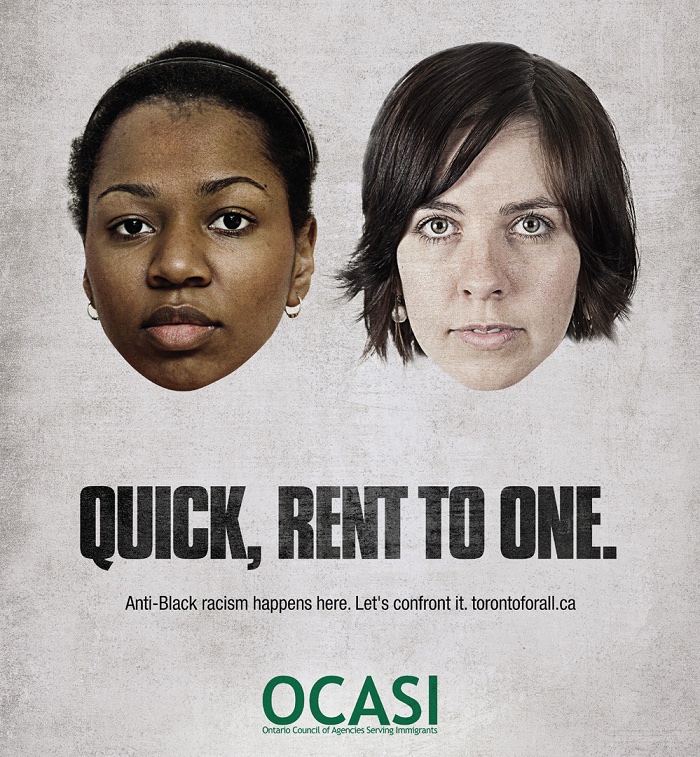By Anthony Fava, Maya Fernandez, & Kane Geng

Toronto for All is a public education initiative to generate dialogue among Toronto residents in order to create a city that says “no to all forms of discrimination and racism, including systemic racism.” The campaign includes a series of events and activities that are open to all residents and visitors, regardless of their background or identity.
Most importantly, it encourages open discussions with community leaders. The goal of the campaign is to promote understanding and respect for our differences, and to build a city that is safe and welcoming to everyone.
There are three sections on their landing page for anti-black racism: Check Your Bias, Moving Forward and Community Guides. Looking at the Community Guide page, we believe there is a problematic framing embedded in their narrative.
When referring to the Toronto Anti-Violence Intervention Strategy, also known as TAVIS, the community conversation guide states “TAVIS was implemented as an intensive violence reduction…aimed to reduce crime and increase neighbourhood safety.”
However, as activist Desmond Cole states, TAVIS was “responsible for the disproportionate share of carding” and directly lead to racial profiling.
The framing of TAVIS on the community guide does not reflect the real world implication and impact of the unit. On the other hand, the framing contradicts the initiative’s own goal of eliminating racial profiling/carding.
In this case study, we think it is also important to highlight how the marketing for this campaign seems to emphasize the frame of “Other” which further divides BIPOC communities.

The image above is part of the Toronto For All campaign. This poster is striking, as it seems to be ‘daring’ the viewer to rent to one of these two groups of people. When discussed in class, there was some discussion on the message, particularly if it was effective or not.
Some of the opinions echoed what our group had previously discussed, for example that the message was unclear and seemed to reinforce the idea of “otherness.” A classmate even said the poster reminded them of a mug shot. Also, a lot of suggestions were along the lines of “give me more information on that person, that’s what I would want to know to rent to one.”
On the other hand, some classmates thought the poster was effective because it sparked a conversation and evoked strong emotion. The Toronto for All campaign revolves around encouraging conversation around these topics, therefore in that sense it would be achieving its marketing goal.
However, other classmates disagreed as they argued most people would not have the time or ability to read the small lettering in the poster saying “Anti-Black Racism Happens Here. Let’s Confront it. Torontoforall.ca.” Thus, it is unlikely the viewer would understand what the campaign is for, defeating its purpose.

The image above is a poster design for the Toronto for All Anti-Black Racism and Mental Health landing page. The poster is contradicting, as it looks grim but the message is meant to be uplifting “MANY FACES, MANY PLACES, BUILDING TOGETHER.”
It is grim because it seems to be worn out or dirty and it is also in black and white. Similar to the last poster, the letters that indicate what the poster is about are small and hard to read.
During the in class discussion, some classmates agreed that the message was confusing, and that the imagery felt industrialized – resembling a prison wall. A classmate even pointed out how it says many faces, but there are no faces in the poster. Instead, it uses the bricks as building together, which was cause for confusion.
Black Mental Health Week is described on the landing page as “a week to raise awareness about the harms of anti-Black racism on mental health in Toronto’s Black communities, and the need to action systemic change.” In general, we believe the poster lacks focus, and fails to communicate or address any relevant issues.
Discussion Questions
- How could this campaign be improved? What strategies would you use to raise awareness about racism?
- What tangible changes could the city do to make it more inclusive? How could the profession of communications play a role?
Bibliography
Cabrera, Holly. “’Screaming for Change’: Repentigny, Que. Residents Demand Action on Racial Profiling at Sit-In.” CBC News. CBC, 2022. https://www.cbc.ca/news/canada/montreal/sit-in-repentigny-police-shot-black-man-1.6538532?fbclid=IwAR1NwQmBzV3A4C_-sm58DDB0P52r-72bMukRfJdn1MPSKTH_n7As-nVBAm8.
City of Toronto. “Anti-Black Racism & Mental Health.” City of Toronto, 2022. https://www.toronto.ca/community-people/get-involved/community/toronto-for-all/anti-black-racism-mental-health/.
City of Toronto. “Toronto For All.” City of Toronto, 2022. https://www.toronto.ca/community-people/get-involved/community/toronto-for-all/
City of Toronto. “Anti-Black Racism.” City of Toronto, 2022. https://www.toronto.ca/community-people/get-involved/community/toronto-for-all/anti-black-racism-2/
Cole, Desmond. “Negro frolicks (january).” In The skin we’re in: A year of Black resistance and power, 1-18. Toronto: Doubleday Canada, 2020.
Cole, Desmond. “Direct action (april).” In The skin we’re in: A year of Black resistance and power, 61-78. Toronto: Doubleday Canada, 2020.
MacKenzie, Angela, and Rachel Lau. “’Instead of Getting Help, He Got Three Bullets’: Family of Man Killed in Repentigny Demand Answers.” CTV News. CTV News , 2021. https://montreal.ctvnews.ca/instead-of-getting-help-he-got-three-bullets-family-of-man-killed-in-repentigny-demand-answers-1.5531728
